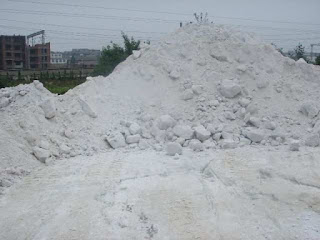Flotation reagent-Frothers, Extenders,and Activators
In mineral processing plant,a number of
organic and inorganic reagents are used in flotation and auxiliary processes to
achieve separation, including collectors, frothers, extenders, activators,
depressants, deactivators, flocculants, and dispersants. Collectors, frothers,
and extenders are surfactants added to impart hydrophobicity to the minerals
and to make selective adsorption of the collector possible or to eliminate
interference to flotation by various dissolved or colloidal species. We discuss
Frothers, Extenders,and Activators this article.
Frothers
The
bubbles that rise to the top of the flotation cell must not break until they
are skimmed off to collect the floated particles. To produce the desired
stability of the froth that forms in the cell, nonionic surfactants such as
monohydroxylated cresols are usually added unless the collector itself can act
as a frother. When long-chained collectors such as oleic acid are used, they
will adsorb also at the bubble surface in sufficient amounts to achieve an
elastic surface and stable bubbles. However, when short-chained chemicals such
as ethyl xanthate are used as collectors, additional reagents must be added for
froth stability. Table 1 lists some commonly used frothers.
Along
with the benefits of froth stability, frother species can co-adsorb with the
collector on the particle. Also, the frother on the bubble surface can migrate
to the particle–gas interface during the time of contact to arrive at the desired
equilibrium adsorption density at that interface on the solidbubble contact
perimeter. Such migration and co-adsorption of the frother can anchor the
bubble onto the particle and cause it to adhere as desired.
In
addition to frothers and collectors, nonionic and nonpolar surface-active
agents are used in many flotation schemes simply to enhance the hydrophobicity
of the particles and the resultant flotation recovery. Kerosene and fuel oils
are used in the flotation of phosphates and coal, for example. These reagents
are thought to act by forming a multilayer coating on the already partly
hydrophobic surfaces.
They can
also act like frothers by co-adsorbing with collectors. Intensive agitation is
required in some cases to disperse and “smear” these reagents onto particle
surfaces.
Activators
Many
minerals do not adsorb collectors, so they do not float unless special reagents
are added to activate adsorption. For example, oleate will not float quartz on
its own, but flotation will occur when calcium salts are added to the pulp at
high values of pH where hydrolysis of Ca2+ has occurred. Similarly, copper sulfate acts as an activator for the
flotation of sphalerite using xanthate as a collector at relatively low
concentration. An activator normally acts by adsorbing on the mineral,
providing sites for adsorption of the collector species. Copper ion exchanges
for zinc ion of the mineral surface, and the sphalerite particle then behaves
in flotation like a copper sulfide particle.
Multivalent
ions can adsorb on oppositely charged particles and reverse their zeta
potential, causing adsorption of collectors that have a charge of the same sign
as that of the mineral. An example is sulfate activation of alumina.



评论
发表评论